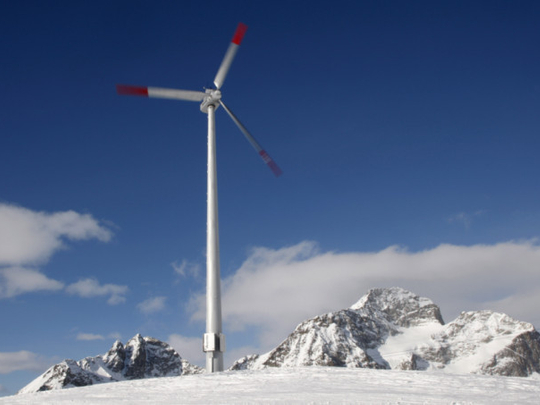
The most important and longest-serving source of renewable energy in Switzerland is hydropower, accounting for around 56 per cent of current domestic electricity production. However, domestic power production is still only around 60 per cent of total energy consumption, with most of the rest coming from nuclear power plants, which are due to be phased out by 2034. The remaining 40 per cent of energy used is imported, mostly from fossil fuels, according to the latest data from the Swiss Federal Office of Energy. Swiss households spend an average CHF890 (Dh3,613) on annual electricity bills, as of October 2012.
Thus, the rising cost of imports and the need to reshuffle the domestic energy mix have resulted in a comprehensive roadmap for transitioning to renewables.
“It is a fact that Switzerland can’t afford not to transition to renewables if we look at the overall costs,” says Bernhard Piller, Project Manager of Costs of (Non)Transitioning, a study issued in June by the Swiss Energy Foundation. Piller says shifting to renewables will cut the cost of imports by 16 per cent by 2050, translating into seven billion Swiss francs in savings for the country.
“A transition will pay off in any case,” Piller adds. “Given a moderate oil price development, it will be profitable for Switzerland by 2040, and even from 2020 under a high-price scenario.”
No wonder that the Swiss government is pushing all kinds of innovations in the renewable sector, which include solar, wood, biomass, wind, geothermal and ambient heat. As it stands, wood and biomass, ambient heat, electricity from small-scale hydropower plants and, to a moderate extent, wind, are available — and in some cases, already economically attractive. Others, such as photovoltaics or geothermal energy, will become economically viable in approximately 30 years’ time, “primarily for economic reasons,” says Frank Rutschmann, Head of the Renewable Energy Section at the Swiss Federal Office of Energy.
Perks of power
To incentivise producers of green energy, Switzerland has introduced a generous Feed-In-Tariff, a remuneration that covers the difference between the production and the market price. Without this, no renewables project would be profitable at this point of time. Additional costs are shouldered by consumers.
Most alternative energy presently comes from small-scale hydropower plants, where innovation in green energy first started. Switzerland was the first country where researchers sought to put technologies and techniques into practice in this sector, and one of them was the so-called gravitation water vortex technique. A gravitation water vortex plant functions differently from traditional hydroelectric facilities. It has a rotation tank equipped with a central outlet above which a stable, symmetrical vortex forms. It then drives the turbine thanks to the gravitational force between the turbine and the outlet. About 97 per cent of electricity production out of such a water vortex plant is CO2-free, say the operators of the largest plant of its kind in Schöftland, in the canton of Aargau.
In another innovative approach to utilising alternative energy, farmers in the canton of Lucerne came together to develop a new high-tech biogas plant to make use of animal manure and other sorts of bio waste. The result was a first-of-its-kind biogas plant that combined wet and dry fermentation, making it possible to convert both solid and liquid biodegradable waste such as plants, manure and slurry into biogas. The resulting gas is fed into the regional natural gas network, and also sold as CO2-neutral fuel for natural gas vehicles. The plant is able to process a huge variety of waste, ranging from plants and coffee grounds to farmyard manure and even liquids such as slurry, oil from the food industry, sugared water left over from milk production, and even household and restaurant food residues such as potato peels.
“People realised they can heat their rooms with biogas from potato peels, cook with gas from foliage, and power their cars with energy from frying oil,” says Philip Gassner, CEO of SwissFarmerPower Inwil AG, a joint stock company of 73 farmers from the region.
“With one tonne of green waste, a car can drive a 1,000 kilometres and save 150 kilograms of CO2,” he adds.
Sustainable sites
Another milestone in green energy use in Switzerland was the introduction of so-called eco-neighbourhoods, the developments being built in accordance with principles of sustainability. Features include the use of renewable and recyclable building materials, energy-efficient heating systems that dramatically cut CO2 emissions, the complete absence of fossil fuels, rainwater collection and methods of household waste recovery such as composting. Furthermore, most initiatives tend to discourage individual car ownership, encouraging better public transport links and car-sharing schemes instead.
Some ten eco-neighbourhoods have already been or are currently being built in Switzerland, mostly on abandoned industrial sites, former rail corridors and vacant lots. The largest current project is the Métamorphose development in Lausanne, which will see the redevelopment of the city’s former Olympic stadium into a high-value sustainable neighbourhood.
Such distinct neigbourhoods have also been the role model for the development of the Swiss Village in Abu Dhabi’s green development Masdar City, a $22billion project funded by the Abu Dhabi government 17 kilometres south-east of the UAE capital, to create a waste-free, low-carbon and mostly car-free city.
The Swiss Village, which is currently in its planning stages, should serve as the home to a number of Swiss companies with expertise in clean technology, aiming to become one of the major drivers of green technology research and innovation in the region. However, there have been some delays in progress, and the city as a whole, which was originally intended to be completed by 2016, should be finished between 2020 and 2025.








